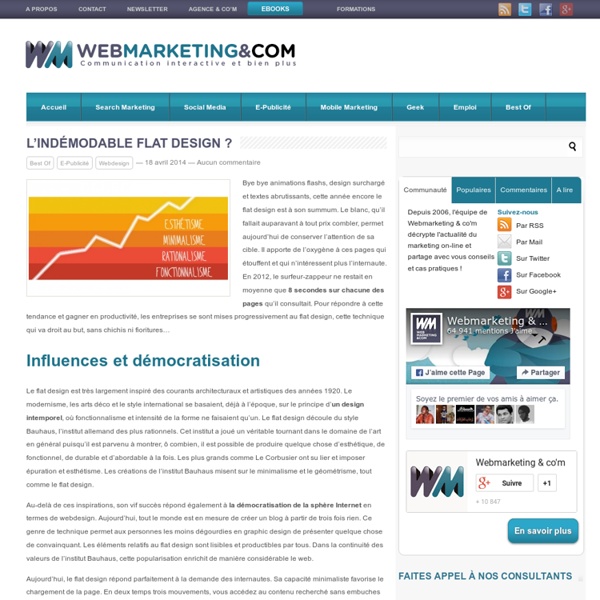L’indémodable flat design

Réduisez le temps de création de vos pages avec le générateur d’effets graphiques CSSmatic
est un tout nouveau site gratuit où les web-designers trouveront une trousse d’outils CSS d’effets graphiques des plus complètes. Très intuitive, elle leur fera gagner un temps précieux en leur permettant de ces effets et interminables et complexes qu’ils ont l’habitude de saisir manuellement pour appliquer ces effets graphiques à leurs pages web. Développés en JavaScript, ces outils permettent à l’utilisateur de créer des types d’effets percutants, de copier le code et le coller dans leur feuille de style. Les effets graphiques disponibles sont : les dégradés, les styles des bordures, les textures avec ajout de bruit et les ombres portées. Le vous aide à créer des dégradés de couleurs multiples et d’opacités variables, dans le plus pur style Photoshop. L’outil vous permet de créer des bordures de blocs avec des . L’outil de est un moyen facile d’ajouter des textures plus complexes à vos fonds. Enfin les vous aideront à finaliser votre création. Trackbacks
3d Animated GIF Showcase
Long ago people have noticed the soothing and even hypnotic effect, when watching certain cyclic movements. Rhythmic swings of the pendulum or instantaneous water flow may easily bring a person into a trance condition, helping him to dive into the personal inner world. Similar effect can be achieved with the help of a particular type of digital graphics, known as animated .gif images. When a number of certain static images, such as geometric figures, for example, interchange with a specified frequency, it creates something like a motion picture effect. Watching such “live” images produce really fantastic and exciting visual effects. Need evidences? Actually, the range of applications of the animated .gif images is vast: from making attractive navigation buttons and cute icons for web to creating magnificent digital art works. tag) have made animated gif images popular and widely-used elements of web design. 3d Gifs by davidope Life by cyberchaos Triangular inverse by Emilio Gomariz
Scaffolding
Requires HTML5 doctype Bootstrap makes use of certain HTML elements and CSS properties that require the use of the HTML5 doctype. Include it at the beginning of all your projects. <!DOCTYPE html><html lang="en"> ... Typography and links Bootstrap sets basic global display, typography, and link styles. Remove margin on the body Set background-color: white; on the body Use the @baseFontFamily, @baseFontSize, and @baseLineHeight attributes as our typographic base Set the global link color via @linkColor and apply link underlines only on :hover These styles can be found within scaffolding.less. Reset via Normalize With Bootstrap 2, the old reset block has been dropped in favor of Normalize.css, a project by Nicolas Gallagher and Jonathan Neal that also powers the HTML5 Boilerplate. Live grid example The default Bootstrap grid system utilizes 12 columns, making for a 940px wide container without responsive features enabled. Basic grid HTML <div class="row"> <div class="span4">... Offsetting columns
Bootstrap - Extensions
“The perfect site layout in just a few minutes” Twitter Bootstrap is the greatest solution for designing CSS based, responsive web layouts and now with the help of the DMXzone Bootstrap extension, it is fully integrated in Dreamweaver! Directly in its design view, you can now fully visual create fluid or fixed grid layouts and follow your work in progress for mobile and desktop browsers by selecting the desired size for mobile phones, tablets or desktop. For even more power and additional 35 ready to go Bootstrap Elements check the DMXzone Bootstrap Elements Extension! Bootstrap 3 is already available as Dreamweaver extension! Features General Features Twitter Bootstrap 12-column responsive grid - The responsive grid system ensures proper content proportions for different resolutions and devices. Support for advanced grid layouts and nested columns - You can add as many rows as you wish within a column. Fluid grid layout Showcases Videos Requirements Type: Suite
Related:
Related:



